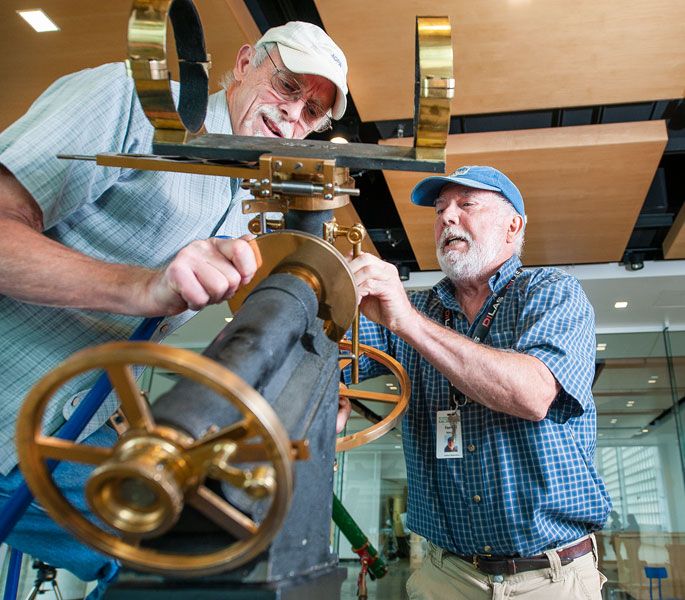Back on sky watch

More than 40 years ago, Linfield University, then college, dismantled the telescope from its tiny observatory and placed it, in pieces, into storage.
Subsequent physics professors and students heard stories about the scope, a refractor from the late 19th century that, for the time, was the best of its kind. It offered astronomers stellar views of the planets and the moon, both when it was newly installed at what was then McMinnville College and into the 1960s and 70s, when the late Professor Win Dolan used it in his classes.
Bill Mackie was one of Dolan’s students who went on to teach physics at Linfield and co-found Applied Physics Technologies, a leader in field emissions research.
On Wednesday, he helped carefully lift and place precious pieces of the historic telescope onto its stand in the Evergreen Space Museum in McMinnville.
It’s one of several telescopes donated by Linfield, including a Celestron, a Questar and a 25-inch mirror Dobsonian scope called “The Obsession,” considered the ultimate private telescope for viewing the deep sky.
Along with telescopes from the private nonprofit Carlton Observatory group, the Linfield scopes are destined for the Carlton Observatory at Evergreen.
But until that building is built in about 2025, they will be on display inside the space museum. A grand opening of the indoor exhibit, marking the start of fundraising for the new facility, will happen Aug. 14.
Complete for the first time since about 1980, the former Linfield Observatory scope looked just as it had when Mackie peered through it as a student, he said.
“This is great. It’s good to have it on public display again,” he said, admiring the 6-inch tube of black steel and brass onto which additional brass pieces were affixed.
Using a refractor, rather than a mirror, the scope features a clock mechanism that allows it to turn as time passes — following the movement of the earth, in other words.
The clock and another important piece, the right ascension, were missing when Linfield Physics Department Chair Jennifer Heath located the tube and other parts of the scope earlier this year. They were stored in the crawlspace below the auditorium in Graf Hall, one of the science buildings.
She also found a box. Inside were the missing telescope parts.
The scope now has been remounted on its 300-pound pedestal that stands more than 4 feet tall. It bears a silver plaque that reads, “Queen & Co. Makers, Philadelphia, PA.”
“We’re super excited it can be here, be used and be accessible,” Heath said. “Our students can come here for projects, or even volunteer at the museum.”
Joseph Murphy, a Linfield physics major from Newberg, attended the telescope reassembly with his professors Wednesday morning.
He said the 19th-century scope’s design caught his attention more than looking at the stars. “It’s very mechanical, lots of small moving parts,” he said. “That piques my interest.”
He’s also interested in its history. “This was part of the Linfield physics department,” he said. “It’s great to see it come back into use.”
Forrest Babcock, an amateur astronomer and telescope expert, worked with Mackie to carefully reassemble the observatory scope. Then he fiddled with this screw and that, making sure the mechanism was secure.
“There was no aluminum at the time this was made, no plastic,” Babcock noted, “so everything is massive.”
Optics have improved since 1888, of course, Babcock said, but still, “it has good resolution, and the clarity is superb.”
Babcock knows telescopes. He has built several, including “Big Blue,” a giant telescope that’s been the centerpiece of star parties and fundraisers since Babcock and his wife, Janet Zuekle, started pushing for the Carlton Observatory to be built several years ago.
Babcock, interested in astronomy since boyhood, worked as a lens polisher for Lawrence Livermore National Laboratory. When one of the huge mirrors was discarded, he rescued and restored it on his own time to become the central part of Big Blue.
He restored Big Blue itself this spring after the theft and recovery of the trailer in which it was stored. Fortunately, he said, the priceless mirror wasn’t in the telescope at the time, so damage was minimal.
Mike Barsotti, a longtime astronomy enthusiast, read about the telescope theft in the News-Register and called Babcock and Zuelke. He soon was on the board for the Carlton Observatory at Evergreen.
He said he’s excited about seeing the public using Big Blue, the Linfield telescopes and other equipment to look at the heavens.
“Most people know little or nothing about what’s up there,” Barsotti said. “But when they see pictures from the Hubble Telescope or look through a telescope themselves, they’re excited and interested. They want to know more.”











Comments